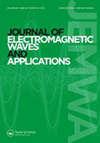LMS and RLS beamforming algorithms based linear antenna array with known mutual coupling
IF 1.1
4区 工程技术
Q4 ENGINEERING, ELECTRICAL & ELECTRONIC
Journal of Electromagnetic Waves and Applications
Pub Date : 2023-09-15
DOI:10.1080/09205071.2023.2251979
引用次数: 0
Abstract
AbstractThis study explores the application of LMS and RLS algorithms in adaptive beamforming for a linear array of half wavelength dipole (HWD) antennas with known mutual coupling. The research initiates by deriving analytical expressions for the covariance matrix of signal impinging on an HWD antenna array, accounting for mutual coupling effects. Leveraging these expressions, we calculate the weights for both LMS and RLS algorithms, enabling the evaluation of the overall far-field radiation patterns of the HWD antenna array. The results demonstrate that these algorithms effectively steer the main lobe of the radiation pattern towards the desired user while creating nulls in the direction of undesired users. Notably, simulations indicate that the proposed compensation method enhances the performance of beamforming algorithms, particularly when considering mutual coupling effects. Specifically, the LMS algorithm outperforms the RLS algorithm in reducing interference, resulting in lower side lobe levels (SLL) in the radiation pattern.KEYWORDS: Beamforming algorithmsdipole antenna arraysmutual couplingLMSRLS Disclosure statementNo potential conflict of interest was reported by the author(s).基于已知互耦线性天线阵的LMS和RLS波束形成算法
摘要研究了LMS和RLS算法在已知互耦的半波长偶极子(HWD)天线线性阵列自适应波束形成中的应用。首先推导了考虑互耦效应的信号撞击HWD天线阵协方差矩阵的解析表达式。利用这些表达式,我们计算了LMS和RLS算法的权重,从而能够评估HWD天线阵列的整体远场辐射方向图。结果表明,这些算法有效地将辐射方向图的主瓣指向期望的用户,同时在不期望的用户方向上产生空值。值得注意的是,仿真表明,该补偿方法提高了波束形成算法的性能,特别是在考虑相互耦合效应的情况下。具体来说,LMS算法在减少干扰方面优于RLS算法,从而降低了辐射方向图中的旁瓣电平(SLL)。关键词:波束形成算法偶极天线阵列互耦lmsrls披露声明作者未报告潜在利益冲突。
本文章由计算机程序翻译,如有差异,请以英文原文为准。
求助全文
约1分钟内获得全文
求助全文
来源期刊
CiteScore
3.60
自引率
7.70%
发文量
116
审稿时长
3.3 months
期刊介绍:
Journal of Electromagnetic Waves and Applications covers all aspects of electromagnetic wave theory and its applications. It publishes original papers and review articles on new theories, methodologies, and computational techniques, as well as interpretations of both theoretical and experimental results.
The scope of this Journal remains broad and includes the following topics:
wave propagation theory
propagation in random media
waves in composites and amorphous materials
optical and millimeter wave techniques
fiber/waveguide optics
optical sensing
sub-micron structures
nano-optics and sub-wavelength effects
photonics and plasmonics
atmospherics and ionospheric effects on wave propagation
geophysical subsurface probing
remote sensing
inverse scattering
antenna theory and applications
fields and network theory
transients
radar measurements and applications
active experiments using space vehicles
electromagnetic compatibility and interferometry
medical applications and biological effects
ferrite devices
high power devices and systems
numerical methods
The aim of this Journal is to report recent advancements and modern developments in the electromagnetic science and new exciting applications covering the aforementioned fields.

 求助内容:
求助内容: 应助结果提醒方式:
应助结果提醒方式:


